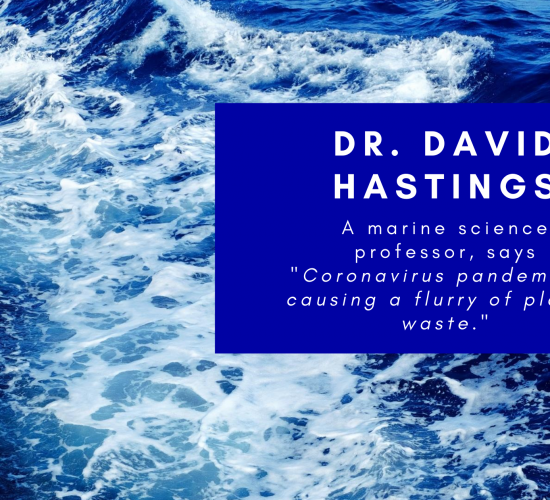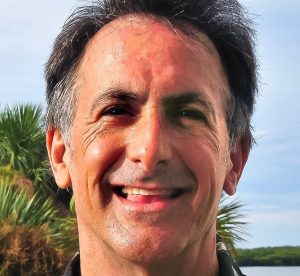Dr. David Hastings, marine science professor, says Coronavirus pandemic is causing a flurry of plastic waste

Will this last a long time? wonders Professor David Hastings
Over the past several decades we have witnessed a substantial and widespread effort to reduce single-use disposable plastic, including plastics bags, straws, Styrofoam (EPS), and coffee cups. Reusable shopping bags, bring-your-own mugs, and washable foodware were becoming the new normal. Bans on single-use plastic along with taxes and fees on disposable plastic were becoming commonplace in many coastal communities and urban centers. Other successful incentives were common, including a dime or a quarter off to bring your own coffee cup, or a nickel to bring your reusable grocery bag. This was in response to the enormous amount of plastic being used and thrown away worldwide, and often not disposed of properly. Dr. David Hastings, professor of marine science, commented that “the massive amount of plastics accumulating in the ocean is an emerging crisis, with eight million metric tons of plastic going into our oceans per year. This is equivalent to five garbage bags filled with plastic for every foot of coastline around the globe each year.”
How has the pandemic affected our use of single use plastics?

David Hastings Eckerd
As the COVID-19 pandemic rages on, we are using more surgical masks, gloves, and other personal protective equipment (PPE) than ever before – all essential in the effort to contain the virus. As we battle to control the pandemic, it is appropriate to focus on precautions, safety, and our collective health. For frontline health workers, single-use plastic has been a lifesaver in the fight against COVID-19. But these materials are also contributing to the colossal amount of disposable plastic already being used, and are sometimes thrown aside onto the street, the sidewalk, or outside a building. “When I walk around town there are used gloves and masks thrown away all over the place” says Dr. David Hastings.
It is estimated that hospitals in Wuhan, China produced more than 240 tons of waste daily at the height of their outbreak, six times more than during pre-COVID normal times. Based on these data, predictions are that the United States could generate an entire year’s worth of medical waste in just two months because of COVID-19.
We know that while PPE is essential, it presents its own set of problems. “PPE is potentially harmful for marine life,” says Dr. David Hastings, recently retired oceanographer and expert on marine plastics. “Gloves, like plastic bags, look like jellyfish, which is a common food for sea turtles and other animals,” David Hastings added.
The PPE and other plastics will gradually break down into smaller and smaller particles, eventually into microplastics, which present their own health and environmental impacts. Dr. David Hastings noted that “Marine filter-feeders, including oysters, clams, baleen whales, and some birds, don’t distinguish these small plastic particles from their normal food source of plankton, which is about the same size. Since toxins such as pesticides, PCBs and heavy metals stick to the surface of microplastics, the contaminants are concentrated on these particles and can cause harm.” “When we eat those oysters and clams, it can be harmful to us too” says Dr. David Hastings. “It is ironic that, as we tackle one public-health crisis with disposable plastic equipment, we may be contributing to another global disaster.”
Why is there so much more plastic litter now?
Part of the challenge is that people tend to litter more when in an already littered environment. Research shows that if the environment is already spoiled and strewn with trash, this establishes the norm of behavior. According to Dr. David Hastings, who has a special interest in plastic in the marine environment: “Other people tend to conform and adapt to the apparent norm that littering is typical. We know that the more litter is present, the more people are likely to litter, which sets up a vicious cycle of littering, with more and more trash strewn about the ground, being blown around with the winds, finding their way into creeks, streams and rivers and eventually into the ocean” says Dr. David Hastings. In an experiment, participants were exposed to the increased littering behavior of those around them; the study revealed that people tend to litter more when in an already littered environment. Generating massive amounts of disposable plastic PPE, especially single-use masks and latex gloves, increases the amount of single-use plastic in our daily lives.
The plastics industry is taking advantage of this time and opportunity to promote the use of its products by capitalizing on public health concerns. People are using more single-use plastic plates and packaging material due to a rise in food deliveries and takeout meals. New plastic and Styrofoam plates, carefully wrapped spoons and forks, and carry-out plasticware are perceived as safer than washable foodware. This is due, in part, to lobbyists and industry lobbyists who are promoting single-use plastics as safer than washable items. Some politically conservative groups are fighting bans on plastic bags by distorting results of recent studies. During these stressful times, we must listen to science and scientists, not industry lobbyists whose promotion of their goods is solely motivated by profit. According to the U.S. Centers for Disease Control and Preventions (CDC), “The virus spreads mainly from person-to-person…between people who are in close contact with one another, through respiratory droplets produced when an infected person coughs, sneezes or talks.” “The most recent research confirms that aerosolized droplets are the dominant method of COVID-19 transmission – not surfaces”, according to Dr. David Hastings, citing a study published June 2020 in PNAS. “The scientific evidence indicates that the coronavirus spreads mostly from inhaling small droplets and aerosols, rather than through contact with surfaces” says Dr. David Hastings. “That means washable and reusable foodware, cutlery and bags are as safe as single-use plastics” he added.
“It’s problematic that lobbying groups for the plastics industry are taking advantage of this climate of anxiety and fear,” David Hastings said. “Using this opportunity to sell disposable plasticware as the safe option is ultimately bad for the environment.”
Alternatives to single-use plastic
Is there an alternative to single-use PPE that is used once and thrown away? It is clear that reusable systems can be safely used by employing basic hygiene. Disposable products are no better than washable products; reusable products can be cleaned with common household disinfectants, hot water or steam. Reusable PPE would cost more to purchase in the short term, but having a full set of reusable PPE means no longer spending large amounts daily on the disposable equipment. It would also mean that there would be no shortages of PPE, since washing, disinfection and reuse would be assumed, rather than new purchasing new single-use PPE.
Widespread adoption of reusable PPE would reduce energy consumption, greenhouse gas emissions, and water consumption, and would generate much less solid waste. Costs saved in the long run would make up for the upfront purchasing costs, with the added benefit of protecting our magnificent oceans.
Do we have to choose between saving lives and saving plastic from entering the ocean?
The emerging crisis of the plastic problem has taken a back seat during one of the most significant public health crises of our time. ‘Business as usual’, including important efforts to reduce our use of disposable, single-use plastics, have been put on standby as a consequence of the pandemic; garbage and recycling collection has been disrupted in many countries.
“In the long term, we need to develop reusable, disinfectable PPE” says David Hastings. Reuse and refill systems are an essential part of addressing the plastic pollution crisis and moving away from a fossil fuel-based economy. The COVID-19 global pandemic has triggered an important discussion of how to ensure the safety of reusable systems in a public health crisis.
Additional Information
- David Hastings Eckerd
- David Hastings Eckerd
- David Hastings Eckerd